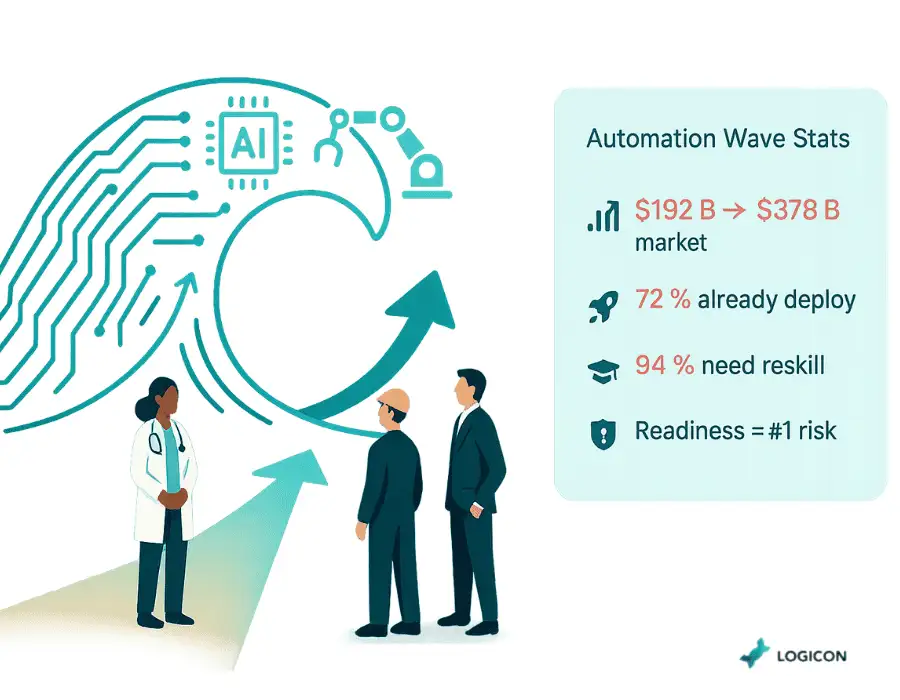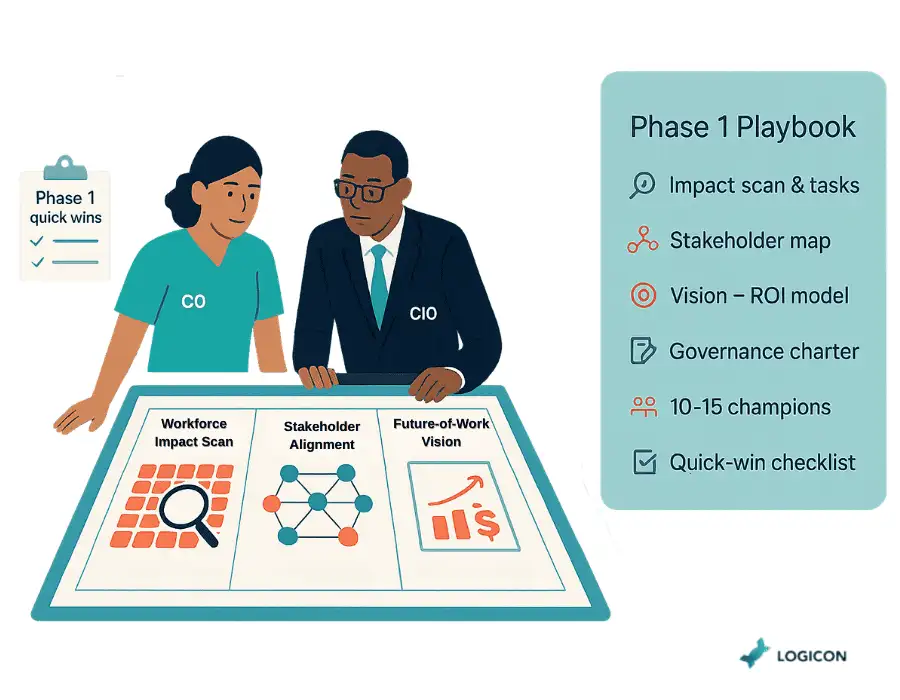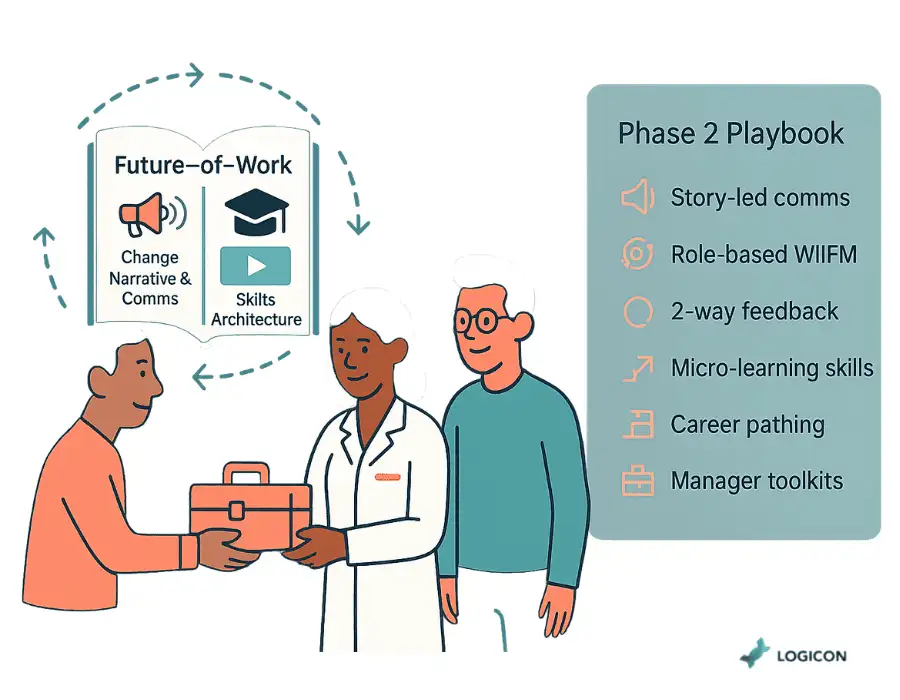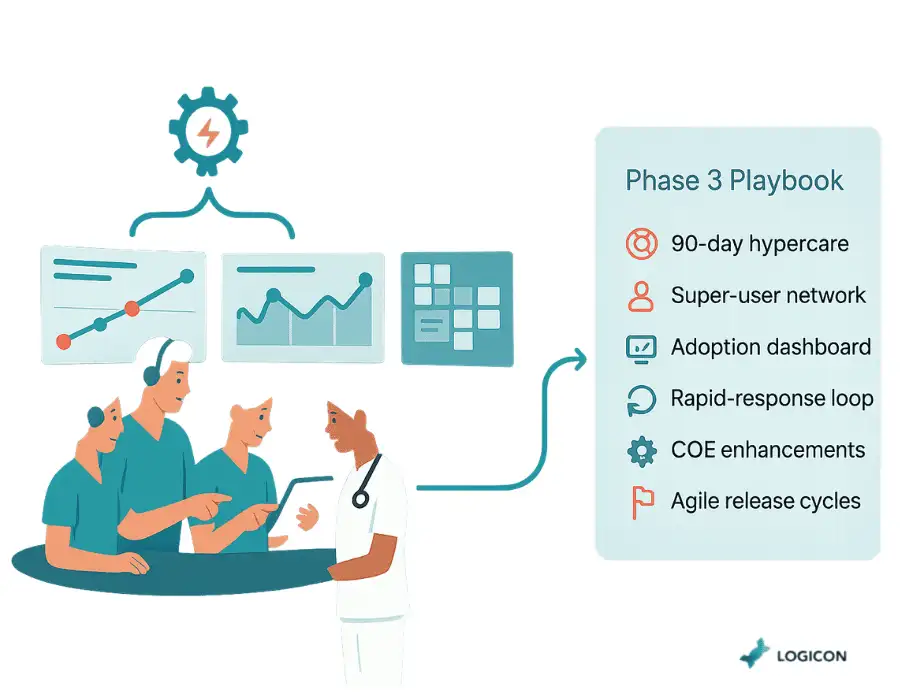Subscribe to our newsletter
The enterprise rush to automate is undeniable, but so is the risk. While the automation market is surging, studies show that technology initiatives that neglect the human element are six times more likely to fail. The true challenge of automation isn’t deploying bots; it’s preparing your people. A reactive approach to workforce transition creates fear, kills productivity, and sabotages return on investment. A proactive strategy, however, builds resilience, unlocks new skills, and turns your workforce into an engine for innovation. This guide provides a pragmatic, three-phase checklist for preparing your workforce for automation—moving from strategic planning and capability building to flawless execution. It is your blueprint for de-risking your investment and capturing the full value of an automated enterprise.
The Automation Wave: Why Readiness Matters Now
The adoption of intelligent automation—the fusion of artificial intelligence with Robotic Process Automation (RPA)—is no longer a future trend; it is a present-day reality. The global market, valued at over $192 billion in 2023, is projected to nearly double to $378 billion by 2030. Already, 72% of organizations are actively implementing automation, driven by intense pressure to improve efficiency, combat staff shortages, and protect razor-thin margins.

This technological shift creates a parallel demand for a human change. It’s estimated that 94% of the current workforce will require significant reskilling to work alongside new automated systems. For leaders in sectors like healthcare, manufacturing, and finance, the message is clear: failing to prepare your workforce for automation is not an option. It is the single most significant risk to realizing the promised benefits of your technology investments. The organizations that thrive will be those that treat workforce readiness with the same rigor and strategic foresight as the technology deployment itself.
Phase 1: Strategic Assessment & Planning
Before a single process is automated, a foundation of deep understanding and strategic alignment must be built. This phase is about mapping the human terrain of your organization to ensure your automation strategy is aimed at the correct targets, supported by the right people, and designed to achieve measurable business outcomes.

A. Workforce Impact Scan
The goal is not to identify jobs to eliminate, but to pinpoint tasks to augment. A granular, task-level analysis reveals which roles will be most affected and what new skills will be required.
- Task & Process Mining: Use analytics tools to identify the high-volume, repetitive tasks that are prime candidates for automation.
- Role Evolution Mapping: For each impacted role, map the transition from the “current state” of tasks to the “future state,” highlighting the shift toward higher-value work like analysis, problem-solving, and customer interaction.
- Readiness Scorecard: Develop a scorecard to assess each department’s readiness for change, factoring in digital literacy, leadership quality, and past experiences with technology adoption.
B. Stakeholder Mapping & Executive Alignment
Automation is a team sport that requires buy-in from the C-suite to the front line.
- Influence/Interest Grid: Map key stakeholders—from executive sponsors and department heads to union representatives and informal influencers—to understand their motivations and concerns.
- Champion Identification: Recruit a network of respected clinical and operational leaders to act as champions. Their role is to co-design the solution and advocate for it among their peers.
- Governance Charter: Establish a cross-functional steering committee with apparent decision-making authority (using a RACI model) to oversee the entire program.
C. Future-of-Work Vision & Business Case
A compelling vision, backed by a credible business case, is essential for securing resources and inspiring the organization.
- Articulate the “Why”: Frame the automation initiative not as a cost-cutting measure, but as a strategic move to create a more engaging work environment, improve service quality, and build a more resilient organization.
- Metrics-Driven ROI Model: Build a business case that goes beyond simple FTE replacement. Quantify the expected impact on key metrics like employee retention, operational throughput, error rates, and compliance.
- Risk Adjustment: Acknowledge the risks of not acting, including the rising costs of manual labor, the impact of burnout on quality, and the competitive disadvantage of operational inefficiency.
Phase 1 Checklist: Quick Wins
- Complete a task-level automation opportunity scan for at least two departments.
- Identify and recruit a core group of 10-15 clinical or operational champions.
- Secure formal sign-off on the program charter and governance structure from the executive sponsor.
- Draft a one-page vision document that clearly articulates the “WIIFM” (What’s In It For Me) for employees.
- Build a preliminary ROI model that includes both hard savings and risk avoidance.
Mini-Case Vignette:
A national financial services firm planned a major RPA rollout in its claims processing division. Before seeking board approval, the CIO partnered with the COO to conduct a detailed workforce impact scan. They demonstrated that automation would not only reduce processing costs but would also free up experienced analysts to focus on complex fraud detection, a significant revenue protection activity. This strategic, value-focused business case secured a budget 20% larger than initially requested, with funds earmarked explicitly for reskilling and change management.
Phase 2: Capability Building & Engagement
With a solid plan in place, the focus shifts to preparing the people. This phase is about building the skills, trust, and momentum needed for a successful transition.

A. Change Narrative & Multi-channel Communications
Proactive, transparent communication is the antidote to the fear and uncertainty that automation can create.
- Translate Strategy into Story: Convert the “Future-of-Work Vision” into a compelling narrative with clear, honest messaging. Address concerns about job security head-on.
- Targeted “WIIFM” Messaging: Customize communications for different roles, emphasizing how automation will reduce their specific frustrations and enable more rewarding work.
- Establish Feedback Loops: Use a mix of channels—town halls, manager-led huddles, anonymous pulse surveys, and an “Ask Me Anything” intranet page—to create a genuine two-way dialogue.
B. Skills & Learning Architecture
Reskilling is the core of the workforce transition. A modern learning strategy is agile, personalized, and continuous.
- Competency Mapping: For the roles most impacted by automation, define the specific future-state skills needed (e.g., data analysis, process improvement, bot management).
- Blended Micro-learning: Develop a curriculum of bite-sized learning modules, including on-demand videos, peer coaching, and hands-on sandbox exercises.
- Career Pathing & Redeployment: Create clear pathways for employees whose roles are significantly changing, showing them a viable and attractive future within the organization.
C. Leader & Manager Enablement
Your frontline managers are your most critical change agents. They must be equipped and empowered to lead their teams through the transition.
- Leader Toolkits: Provide managers with talking points, FAQ documents, and huddle guides to ensure they are delivering a consistent and positive message.
- Change Leadership Coaching: Train managers on how to have empathetic conversations, manage resistance, and coach their team members through the learning process.
KPI Snapshot & Mini-Case:
- Metrics: Employee engagement scores, training module completion rates, manager confidence scores, and reduction in resistance-related help desk tickets.
- Vignette: A multi-state health system preparing to automate revenue cycle tasks identified a significant skills gap. They launched a “coder of the future” reskilling program, offering a certified data analytics curriculum. By communicating this as a career growth opportunity, they achieved an 85% voluntary enrollment rate. This proactive approach prevented costly turnover and built a pipeline of talent for higher-value roles.
Phase 3: Execution, Adoption & Sustainment
This is where the strategy meets reality. A successful go-live and sustained adoption depend on intensive support, data-driven insights, and a commitment to continuous improvement.

A. Go-Live Hypercare & Super-User Network
The first 90 days post-implementation are critical. Over-investing in support during this period is essential.
- Command Center: Establish a central command center for the go-live to rapidly triage and resolve issues.
- At-the-Elbow Support: Deploy an obvious network of super-users and trainers to provide real-time, on-the-floor assistance to staff.
B. Adoption Analytics Dashboard
Move beyond anecdotes and measure adoption with objective data.
- Leading Indicators: Track metrics like training completion, system login rates, and feature utilization.
- Lagging Indicators: Monitor the ultimate business outcomes, such as processing time, error rates, and productivity.
- Rapid-Response Loop: Review the dashboard weekly to identify adoption hotspots and laggards, allowing for targeted, immediate interventions.
C. Continuous Improvement Center of Excellence (COE)
To maximize the long-term value of automation, create a permanent structure for ongoing optimization.
- User-Driven Enhancements: Establish a simple process for users to submit ideas for new automations or improvements to existing ones.
- Agile Improvement Cycles: Use an agile approach to deploy minor, user-suggested enhancements in two- to four-week cycles, demonstrating that feedback leads to action.
KPI Snapshot & Mini-Case:
- Metrics: Time-to-full-productivity, user adoption rate vs. target, number of enhancement requests submitted and implemented, and benefit realization vs. business case.
- Vignette: A global bank used an adoption analytics dashboard to track the rollout of its new automated compliance platform. The data revealed that while the U.S. team was hitting its targets, the London team was lagging. An investigation uncovered a need for region-specific training, which was quickly deployed. This data-driven intervention allowed them to achieve 94% of the projected cost savings within 12 months, far exceeding the industry average.
Industry-Specific Adaptation Tips
While the principles are universal, the application must be tailored.
- Healthcare: Frame automation as a tool to combat burnout and increase time for patient care. Key Metric: Measure the reduction in “pajama time” (after-hours EHR work) for clinicians.
- Manufacturing: Emphasize the partnership between humans and robots to improve safety and quality. Key Metric: Track the reduction in on-the-job safety incidents and rework rates in automated cells.
- Financial Services: Focus on how automation enhances accuracy, ensures compliance, and frees up staff for high-value client advisory work. Key Metric: Monitor the reduction in compliance breaches and the increase in client net promoter score (NPS).
Your Practical Change Management Toolkit
A structured approach relies on proven tools. An effective change management partner like Logicon can equip your team with a ready-to-use toolkit, including:
- Stakeholder Power/Interest Grid Template
- RACI Chart for Governance
- Role-Based Communication Plan Matrix
- Change Readiness Assessment Survey
- Adoption Metrics Dashboard Template
Building the Business Case for Change Management
Investing in change management isn’t an expense; it’s an investment in ROI.
- The 6x Multiplier: Industry data shows that for every dollar invested in effective change management, organizations realize an average of six dollars in return.
- Productivity Protection: A well-managed change can avoid the 56% dip in productivity that typically plagues poorly-run projects.
- Breakeven Math: The business case is simple: the cost of a dedicated change management workstream is a fraction of the price of a single failed, multi-million dollar technology implementation.
Common Pitfalls & How to Avoid Them
| Common Trap | Mitigation Tactic |
| “Announce and Abandon” Comms | Create a multi-phase communication plan that continues for at least 90 days post-go-live to reinforce change and celebrate wins. |
| Ignoring Middle Management | Make managers a primary audience. Provide them with specific training and toolkits to lead their teams effectively. |
| One-Size-Fits-All Training | Develop role-based, workflow-specific training that is delivered in bite-sized, on-demand formats. |
| Failing to Redesign the Work | Mandate that workflow optimization and simplification occur before automation is applied to the process. |
| Lack of Visible Sponsorship | Secure an executive sponsor who will consistently and publicly champion the “why” behind the automation program. |
Future-Proofing Your Workforce Strategy
The nature of work will continue to evolve. A forward-looking strategy builds an organization that is perpetually ready for change.
- Embrace AI for Skills Forecasting: Use AI-powered tools to analyze market trends and internal data to predict what skills your workforce will need in 2-3 years.
- Cultivate “Citizen Developers“: Empower non-IT staff with low-code/no-code automation platforms to solve their departmental problems, fostering a culture of grassroots innovation.
- Reward Experimentation: Build a culture where it is safe to test, fail, and learn. Recognize and reward teams for innovative process improvements, not just for maintaining the status quo.
Conclusion: The Human Path to Automation ROI
Deploying automation technology is now the easy part. The real work—and the real opportunity for competitive advantage—lies in preparing your people. A structured, empathetic, and data-driven approach to change management is what separates a chaotic, low-return project from a transformative success. It ensures your investment in technology translates into a more efficient, resilient, and innovative workforce ready for the future of work.
Is your organization prepared for the human side of automation? Schedule a complimentary Workforce-Automation Readiness Workshop with Logicon’s strategist to build your roadmap to success.